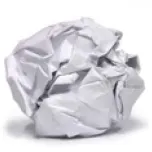Have you ever thought about how much paper we dispose of on a daily basis whilst at work? No, well you should. The other day I was putting a patient on dialysis, a simple cannulation procedure. I washed my hands and placed the paper towels in the domestic waste bag (far too many of them by the way, I want to make sure my hands are really dry, but too many of them just the same, I should be more careful, but I’m not!)
Question: can you put paper towels into the paper bin, our infection control nurse says no, but why, they’re just paper, damp paper - what’s the risk?
[ibimage==749==content_image_full_width==none==self==ibimage_float_left]I then prepared the equipment required for the procedure – I opened my dressing pack, one side paper the other plastic, I opened the fistula needles, one side of packaging paper the other plastic, I then opened the ChloraPrep applicator, again one side paper the other plastic, then 2 Tegaderm dressings. I washed hands again, and still as generous with the drying procedure, inserted the needles, attached the Tegaderm, further 2 pieces of paper, plus the paper on the outside of the dressing!
Then what did I do with the all the different types of waste that I’d accumulated? I placed it in the appropriate bins – well…. clinical waste bin obviously!
That certainly used to be the case but not now. In that procedure alone there were 8 pieces of paper – not that many really, but multiply that by 13,800, that’s how many outpatient Haemodialysis sessions are carried out a year in QMH - how many are carried out in your unit, and where do you put the paper?
So… back to the Haemodialysis procedure itself – I have to get the machine prepared – 1 machine line pack, 1 side paper, the other plastic, 1 priming set, 1 side paper the other plastic, 1 heparin syringe, 1 side paper, the other plastic and 1 filter needle – yes you’ve got the picture, 1 side paper the other plastic. And where do you put that paper?
[ibimage==752==content_image_full_width==none==self==ibimage_float_right]What about during treatment? The weekly erythropoietin, 1 side paper the other plastic, and what if IV antibiotics are needed, a small cardboard box, a syringe and a couple of needles to draw up and administer the drug, and I’ll probably need a giving set which means a ‘Y’ connector, and guess what, they’re all 1 side plastic the other paper, and oops…. I forgot, everyone gets IV iron once a week, so I need another giving set aahhh.., 1 side plastic, and the other paper. So…. How much have you gathered in one day, one week, one year?!!! Well I know I’ve gathered tonnes!......
Did you know…..
- Recycling paper has a lower environmental impact than sending it to landfill or for incineration (WRAP, 2007).
- On average, the production of 100% recycled paper saves 1.32 tonnes of CO2 equivalent (WRAP, 2007).
- It can take just seven days for old magazines and newspapers to be recycled into new ones (WRAP, 2008).
Does it save energy?
- Over 600kg of CO2 equivalents are saved by recycling 1000kg of paper compared to sending them to landfill (Remade).
What happens to paper collected for recycling?
The paper is pulped and recycled into newsprint and other paper products.
[ibimage==755==content_image_full_width==none==self==null]
Enough facts, we all know what we should be doing…. It’s just doing it, thinking of ways to dispose of all that paper we’re using in the simplest and quickest way, especially in a hectic dialysis unit.
Let’s Talk Collecting Rubbish
- Have a day where you watch how much paper is used
- Watch where the paper is disposed
- Do you have a recycling paper bin nearby – is it sufficient?
- Look at your procedures – can you separate the waste easily – if no, think of ways e.g. different coloured bags secured to the trolley
- Get everyone involved, including patients.
Time Consuming?
No….. It’s quite easy to get into the way of pulling the packs apart and separating appropriately, it doesn’t add time to your procedure, and when you realise exactly the amount of paper that your using it becomes addictive (well it does for me!..)
What do you collect your paper waste in?
In Fife we use the cardboard bins that get bashed and look unsightly at times. Did you know the other day I had to chase after the infection control nurse who stole.. (too harsh) removed the paper bins from the HD unit as she said they caused clutter…..any suggestions?....
Finally, if anyone out there is looking into their practice at work on the best way to recycle and collect waste and wants a chat, please feel free to contact me. I’m good at talking rubbish…. Now don’t get me onto plastic!!..
Mary Thomson
Renal Nurse, Queen Margaret Hospital, Dunfermline, Fife
(This blog is the first in my ‘LET’S TALK RUBBISH’ blog series...)
Download Mary's case study poster on reducing, reusing and recycling in Fife below:

Please log in or sign up to comment.